Retention.com: 4 ways to drive more revenue
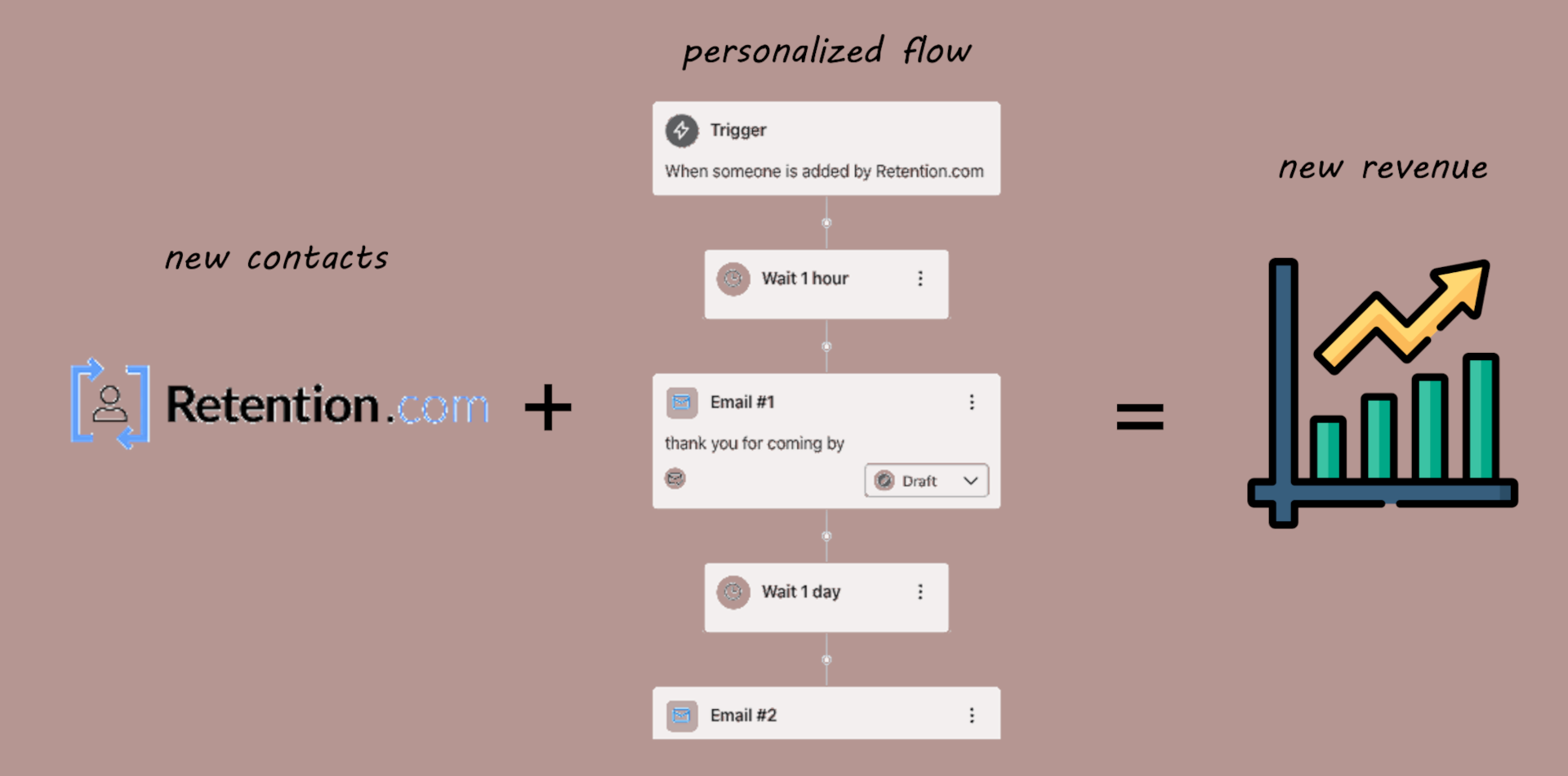
TL;DR:
Retention.com’s role is to capture the contact information of anonymous visitors to your online store. How you engage and monetize this new audience is up to you. We can assist in four different ways.
How did we get here?
Retention.com is the well-publicized story of a company that discovered a little-known technicality: they can utilize the implicit consent of anonymous visitors, rather than requiring explicit consent directly on the brand’s site, to capture contact information from these anonymous visitors.
They act as a middleman, leveraging 3rd-party opt-ins from publishers whose terms of service stipulate that they may sell your data.
According to the company’s materials, this practice is legal in the US and compliant with the CAN-SPAM Act.
When they introduced this offering, it was met with skepticism and many online brands raised their eyebrows.
The reality today is that thousands of online brands are using their service, and what’s even more impressive is that high-profile customers are providing testimonials on their site.
Challenge: highly fragmented buyer journey
The modern shopper uses multiple devices and makes several visits to a variety of online stores before finalizing a purchase. The image below highlights the poor performance of key metrics throughout the buyer’s journey.
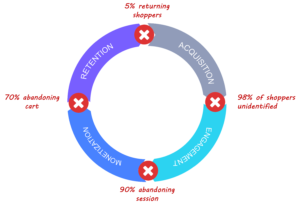
ACQUISITION: Over the last five years, the customer acquisition cost (CAC) has surged by 60%, a rate that is unsustainable for future operations. On a typical site, 98% of all visitors remain unidentified, with their product needs unknown.
ENGAGEMENT: Shoppers are increasingly unlikely to use site search or navigation features to discover products on their own. If a product of interest is not immediately visible, they tend to abandon the site. This behavior explains why 90% of all visitors leave without adding any product to their online cart.
MONETIZATION: Even when a shopper adds a product to their online shopping cart, a purchase is not guaranteed. Due to various factors, including low commitment to the products added, 70% of all online carts are abandoned.
RETENTION: Attracting store abandoners to revisit your site is a challenging task. Only 5% of site visitors are returning customers, primarily drawn back by significant product discounts.
Retention.com solution: identity capture and visitor re-marketing
At its core, the Retention.com solution is simple: it helps you extend the buyer’s journey by identifying store abandoners, allowing you to subsequently engage them via email or SMS, and thereby encourage their return to your store.
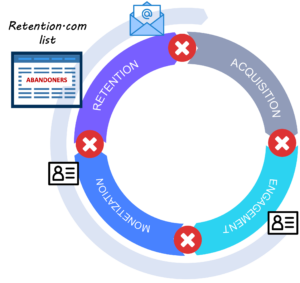
Undoubtedly, the capability to expand your contact list through Retention.com’s identity capture is highly valuable and can significantly lower your customer acquisition costs.
However, this tool alone does not constitute a complete solution. The responsibility falls on you to effectively utilize and monetize it.
FAQs
What is identity resolution in marketing?
What is identity resolution in marketing?
Identity resolution in marketing is the process of integrating multiple identifiers across different devices and platforms to construct a unified, comprehensive view of individual consumers.
This method allows marketers to track and analyze customer interactions over various touchpoints, ensuring that the marketing strategies are both effective and consistent across all channels.
How Identity Resolution Works
-
- Data Collection: Identity resolution starts with gathering data from various sources, such as online behavior, mobile app usage, and offline interactions. This might include data from website cookies, email interactions, social media activity, and in-store purchases.
- Data Integration: The collected data points, which might include names, email addresses, phone numbers, device IDs, and more, are integrated using sophisticated algorithms. This integration process may use deterministic or probabilistic methods:
- Deterministic matching directly links data points using exact matches from personally identifiable information.
- Probabilistic matching uses statistical analysis to link data points based on likelihood, not certainty, which can broaden the scope of data integration under less clear-cut circumstances.
- Creating a Unified Customer Profile: The end goal is to create a comprehensive profile for each customer, which reflects their interactions across all platforms and devices. This unified profile is crucial for delivering a seamless customer experience and for effective personalized marketing.
Is identity resolution effective for ecommerce sites?
Is identity resolution effective for ecommerce sites?
Identity resolution can be highly appropriate and beneficial for e-commerce sites, provided it is implemented in a legal and ethical manner. Here are several reasons why identity resolution can be valuable for e-commerce businesses:
Enhances Personalization
Identity resolution enables e-commerce sites to unify customer data from various touchpoints and channels into a single customer profile. This comprehensive view allows for more targeted and personalized marketing, product recommendations, and communications tailored to individual customer preferences and behaviors.
Improves Customer Experience
With a complete understanding of a customer’s interactions and preferences across different platforms, e-commerce businesses can create a seamless and consistent shopping experience. This could involve ensuring that a customer receives a cohesive service, whether they are shopping online from a desktop, browsing through a mobile app, or interacting via social media.
Increases Marketing Efficiency
By identifying and understanding customer segments more accurately, e-commerce sites can optimize their marketing efforts. This includes more effective segmentation, better targeted campaigns, and efficient use of marketing resources which likely leads to higher conversion rates.
Aids in Customer Retention
Identity resolution helps in recognizing and reacting to customer behavior patterns. For instance, if data shows that a customer typically buys certain types of products or responds well to specific kinds of promotions, this information can be used to enhance loyalty programs or tailor offers, thereby improving customer retention.
Facilitates Accurate Measurement and Analytics
Unified customer profiles enable more accurate tracking and measurement of marketing effectiveness and customer engagement across channels. This comprehensive data allows for deeper insights and more informed business decisions.
Supports Compliance and Data Management
Effective identity resolution can help ensure that customer data is accurately linked and updated, reducing duplicates and errors. This can be crucial for maintaining compliance with data protection regulations by ensuring that all customer information is handled correctly.
Is identity resolution in marketing legal?
Is identity resolution in marketing legal?
Identity resolution is legal, but its legality hinges on how the data is collected, used, and managed, especially in light of stringent data protection regulations like the GDPR (General Data Protection Regulation) in the European Union, CCPA (California Consumer Privacy Act) in California, and other similar laws around the world.
Here are key considerations to ensure the legality of identity resolution practices:
Consent: Under many regulations, explicit consent from individuals is required before collecting and processing their personal data. This consent must be informed, meaning that individuals should be clearly aware of what data is being collected and how it will be used.
Purpose Limitation: Data collected should only be used for specific, explicit, and legitimate purposes that have been communicated to the individual at the time of data collection.
Data Minimization: Only the data necessary for the stated purposes should be collected, and no more.
Transparency: Organizations must be transparent about their data collection and use practices. This involves providing accessible privacy notices that explain the scope of data processing activities.
Data Security: Adequate security measures must be in place to protect the data from unauthorized access, loss, or breaches. This is crucial not only for legal compliance but also for maintaining trust with consumers.
Right to Access and Control: Individuals have rights over their data, including the right to access, correct, delete, or restrict processing of their data. Compliance with these rights is essential.
Cross-Border Data Transfers: Special considerations must be taken when data is transferred across borders, particularly from the EU to other countries. Such transfers are subject to strict conditions to ensure that the level of data protection adhered to is not undermined.
Accountability: Organizations must be able to demonstrate compliance with all applicable laws and principles relating to processing personal data, which may include keeping detailed records of data processing activities and implementing data protection impact assessments.
To navigate these legal considerations, it’s crucial for businesses engaging in identity resolution to work closely with legal experts to ensure that their practices comply with relevant local and international data protection laws. This compliance not only avoids legal repercussions but also helps in building trust with customers, which is fundamental for long-term business success.
... more articles about identity resolution in marketing
… more about identity resolution in marketing
Here are some detailed articles about identity resolution that cover how it works, its benefits, and its implications in marketing:
- Segment – “Identity Resolution: The Definitive Guide”: This article provides a thorough overview of identity resolution, explaining how it helps attribute customer behaviors across all touchpoints to a single unified customer profile. It emphasizes the role of identity resolution in enabling better service and personalized interactions across various teams within an organization.
- Customers.ai – “Unlocking Customer Insights with Identity Resolution Marketing”: This article discusses how identity resolution can offer a unified, 360-degree view of customers by connecting identifiers across devices and channels. It highlights the benefits of having a holistic understanding of customer interactions for more effective marketing.
Explore the insights at Customers.ai
- Merkle – “Identity Resolution: How Marketers Can Get it Right”: It focuses on the practical applications of identity resolution in marketing, detailing how to recognize and target customers accurately across multiple platforms to ensure the delivery of relevant content at the right time.
These resources provide valuable information on the process and strategic advantages of implementing identity resolution in marketing, helping marketers enhance personalization and customer engagement efforts.
Get your FREE Ecommerce Email Score!
Unlock the hidden revenue potential of your email marketing:
- Increase email engagement.
- Use the most effective landing pages.
- Promote the right products.
- Fully monetize every store visit.
Request to join the Beta Program.

Product led growth (PLG) to monetize Retention.com lists
The product-led growth for e-commerce methodology enables your products to essentially sell themselves.
Product-led growth strategy enhances monetization of your new Retention.com contacts by improving product-market fit:
-
- Market: Capturing the identity and attributes of visitors aids in addressing the ‘market’ aspect of product-market fit. However, having an extensive dataset on a visitor’s personal and prior behavior seldom reveals the specific product a shopper intends to purchase.
- Product: To address the ‘product’ side of product-market fit, the product-led growth methodology utilizes live visitor engagements with products as buying signals, adapting to shopper needs throughout the entire buyer journey.
Here are four product-led growth strategies to apply at key stages of the customer lifecycle:
1. RETENTION: Welcome flow
Acting and engaging with new contacts promptly is essential.
Retention.com provides a playbook that guides you on how to leverage your email system and design a welcome flow for newly captured contacts.
CHALLENGE: How to make the email flow relevant to the contacts’ product needs so that an increased number of them return to your online store.
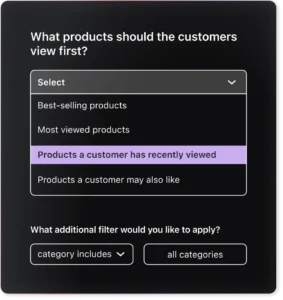
Example: Klaviyo’s product recommendations
RETENTION PLAYBOOK: Merchants are advised to utilize product recommendations via an email system, such as Klaviyo, to promote products based on browsing history or abandoned carts.
While beneficial, these recommendations fall short of closely aligning with shoppers’ implied interests derived from product interactions before site abandonment.
PLG APPROACH: Enhance your emails with personalized recommendations to achieve:
-
-
- A high degree of relevancy for products recommended based on prior abandoned buying sessions.
- The ability for shoppers to discover products they have not yet viewed.
-
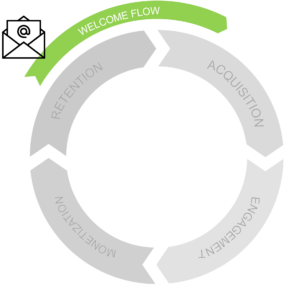
2. ACQUISITION: Merchandizing
Initial page views are crucial in acquiring visitors and are a key determinant of the overall success of the buyer’s journey.
CHALLENGE: How to ensure returning visitors are delighted and prevent repeat store abandonment.
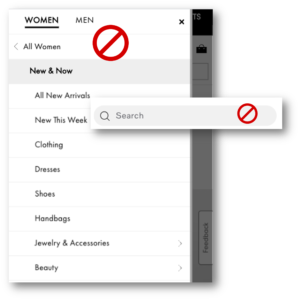
Shoppers are unlikely to use search and navigation
RETENTION PLAYBOOK: Lacks strategies for increasing visitor engagement.
Marketers rely on the current site design and functionality, assuming that shoppers are motivated and willing to put in the effort to discover products that interest them.
PLG APPROACH: ‘Cast a wide net’ with a variety of product recommendations to achieve:
-
-
- An increase in shopper interaction with products.
- Detection of buying signals for further personalization of the buying experience.
-
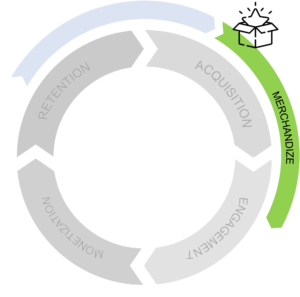
3. ENGAGEMENT: Personalization
Shoppers expect personalized shopping experiences.
CHALLENGE: How to quickly establish product-visitor fit when actual product needs are unknown.

Shoppers often are uncertain about what they want.
RETENTION PLAYBOOK: Personalization is recommended but lacks support.
Common personalization solutions are not optimized for the specific needs of Retention.com contacts.
PLG APPROACH: Adapting to shoppers’ buying signals in real time to achieve:
-
-
-
-
- Connecting visitors as quickly as possible with products they are interested in.
- Reducing cart abandonment by showcasing products that shoppers actually want to buy.
-
-
-
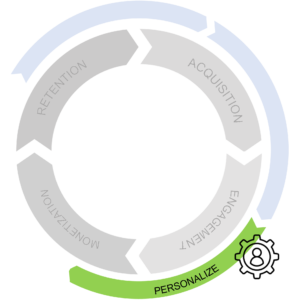
4. MONETIZATION: Upsell & Cross-Sell
It is easier to cross-sell or upsell to a customer who is already making a purchase than to convince them to return and buy a second product later.
CHALLENGE: Identifying which product will maximize the average order value without causing a negative reaction from the buyer and leading to cart abandonment.

Shoppers often are uncertain about what they want.
RETENTION PLAYBOOK: Cross-selling or upselling strategies are not emphasized.
Many popular applications rely on risky, rules-based methods to recommend products for upselling and cross-selling.
PLG SOLUTION: A hybrid approach that merges merchant-defined rules with adaptive algorithms to achieve:
- A consistent increase in average order value.
- An enhancement in overall customer lifetime value.
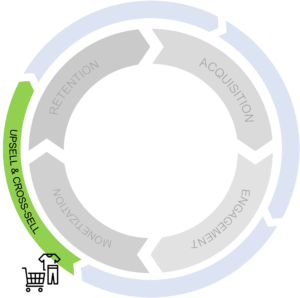
In closing
There’s no question that Retention.com offers a valuable new approach to engaging with visitors at the early stages of the buyer journey. When used effectively, it enables D2C brands to lower their customer acquisition costs.
If you’re looking to fully monetize your investment in Retention.com, Obviyo can help you achieve improved revenue outcomes at every stage of the buyer journey.



